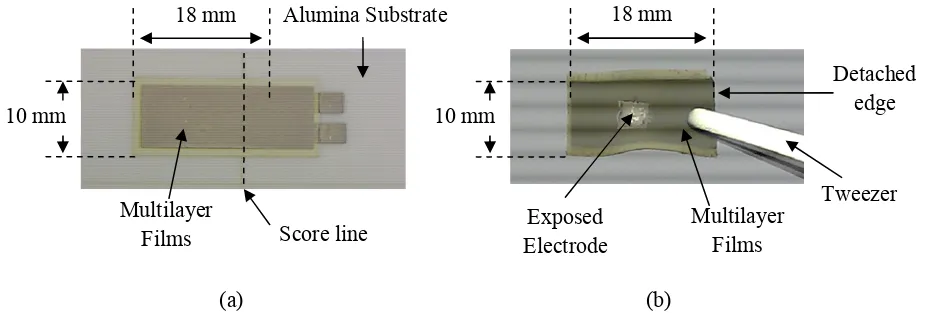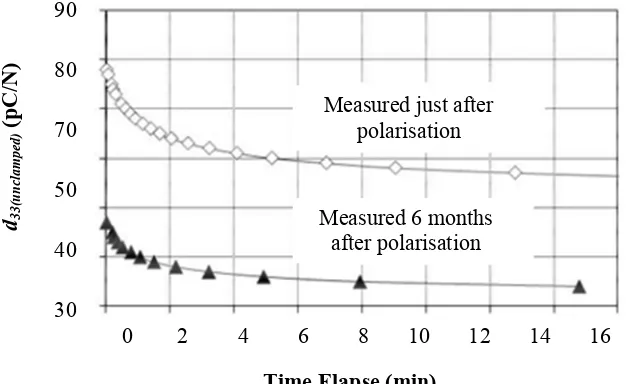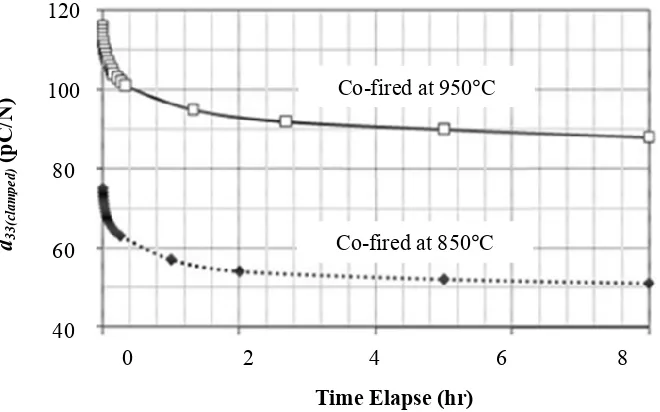Substrate-Free Thick-Film Lead Zirconate Titanate (PZT) Performance
Measurement Using Berlincourt Method
Swee-Leong Kok
1, a, Kok-Tee Lau
2,band Ahsan Qumrul
3,c1Faculty of Electronic and Computer Engineering, 2,3Faculty of Manufacturing Engineering Universiti Teknikal Malaysia Melaka, Hang Tuah Jaya, 76100 Durian Tunggal, Melaka, Malaysia
a [email protected], b [email protected] , and c[email protected]
Keywords: Lead Zirconate Titanate (PZT), Thick-Film, Berlincourt Method, Piezoelectric Charge
Coefficient, d33, Substrate-Free.
Abstract. Lead Zirconate Titanate or PZT is a high performance piezoelectric material which is able to generate charges when a proportional amount of stress is applied on the material. It has the potential to be used to fabricate micro-power generator for powering low power electronic devices, on top of already existence sensors and actuators. One of the indicators for comparing the performance of the smart materials is the piezoelectric charge coefficient, d33. In this paper, the actual d33 of PZT fabricated in the form of substrate-free thick-films were measured using Berlincourt Method whereby a standard dynamic force is applied to the materials and the resultant value of charges is recorded and compared over a period of time after the thick-films were polarized. The d33 values are compared between substrate-based and substrate-free specimens show a difference of about 45 % as a result of clamping effect contributed by d31. The experiment results also show that the thick-film PZT processed at 950 °C and polarized at 220 V with a thickness of about 120 µm has a piezoelectric charge coefficient of 82 pC/N.
INTRODUCTION
Conventionally screen-printed thick-film is rigidly clamped on a substrate once it is co-fired with permanent binder such as borosilicate, therefore imposes difficulty in measuring accurate d33 value. There was an attempt to measure accurate d33 of thin film by eliminating the substrate bending effect using spatial scanning laser vibrometry as described by Glenn and Huang [1], however this measurment method involve costly and dedicated set-up.
Our attempt in this paper is to provide an alternative for accurately measuring d33 in the form of substrate-free thick-film ceramic [2]. Piezoelectric charge constant, d33 is generally a performance indicator of different piezoelectric materials. Berlincourt method was used to measure the resultant charge generated by the piezoelectric material when a standard dynamic force is applied on the materials. The value of the d33 is recorded and compared over a period of time after the thick-films were polarized.
Pz29 which is compatible with conventional soft piezoelectric material PZT-5H, from Ferroperm Piezoceramics [3] is being used in this paper. Two series of specimens were fabricated by co-firing at different profiles with peak temperatures of 850°C and 950°C at a holding time of 10 minutes. In order to make it substrate-free, a sacrificial layer of carbon was printed before the sandwiched structure of electrode-PZT-electrode, which is sublimated during the co-firing process [4].
The measured electrical properties of substrate-free thick-films (free from adhering on substrate) was compared with substrate-based samples (firmly adhered on alumina substrate) to obtain accurate measurement as suggested by Torah et al [5] and Steinhausen et al [6].
BERLINCOURT MEASUREMENT METHOD
Generally there are two categories of piezoelectric material measurements methods: static and dynamic measurement methods. The static method is implemented by either directly applying force to the material and observing the charge generation or by applying constant electric field and observing the dimension change, while the dynamic method is using alternating electrical signal at high frequency to observe the frequency responses of the material [7].
Static piezoelectric measurement can be made by either direct or indirect methods. The direct method, also known as Berlincourt method, is conducted by applying a known force to a piezoelectric sample and the charge generated is measured as shown in Fig. 1.
Fig. 1: A photograph (a) and a schematic diagram (b) showing a piezoelectric specimen being measured with the Berlincourt measurement method.
The relationship between the generated charge and applied force is the piezoelectric charge coefficient as given in equation (1).
(1)
The subscripts i and j are the notations for poling direction and the applied stress direction respectively. A poled piezoelectric material produces a voltage of the same polarity as the poling direction for compressive force and on the other hand, voltage in the opposite direction is produced when tensile force is applied. This method is the simplest way to measure the d33 coefficient by using standard laboratory equipment.
Conventionally, thick-film piezoelectric materials are printed on a rigid substrate such as alumina and stainless steel. In this condition the film is rigidly clamped to the substrate which imposes a deformation restriction on the lower surface of the films when stress is applied as shown in Fig. 2.
There are a few possible types of mechanical clamping for a film printed on a substrate [6]; one of which is where the piezoelectric film is mechanically bonded with an inactive substrate. With the presence of the substrate, an interfacial stress occurs between the printed piezoelectric film and the substrate and causes the measured effective piezoelectric coefficient d33 to reduce from the true value. This is because of the influence of the d31 component in the film when a deformation of the structure occurs.
Fig. 2: Diagram of a substrate-free film in (a) expansion and (b) contraction compared to a substrate-based film in (c) expansion and (d) contraction.
Theoretical analysis [5] shows that a reduction of measured d33 is inevitable for a clamped sample according to
(2)
Whereby, d33(clamped) is the piezoelectric charge coefficient for thick-film printed rigidly on alumina substrate, while d33(free) is the actual piezoelectric charge coefficient of piezoelectric thick-film with no d31 effect, which is free from the constraint of the substrate. S with the superscript E is the compliance (m2 N-1) of the material at a constant electric field, while V
substrate and Ysubstrate are the Poisson’s ratio and Young’s modulus (N m-2) of the substrate, respectively.
Another problem associated with the determination of d33 is the fact that the system of substrate-piezoelectric film acts as a natural bending element. Therefore, to determine d33 correctly, the change in thickness of a specimen between two opposite points at the upper and the lower side of the sample must be measured [6].
MEASUREMENT RESULTS AND DISCUSSION
By substituting the parameters for the properties of an alumina substrate and a substrate-based thick-film as listed in Table 1 into equation (2), the substrate-free d33 can be estimated, which is slightly more than 80% compared to the measured value of a clamped sample.
The measured piezoelectric charge coefficient decayed as a continuously varying stress was applied to the materials. This is a common phenomenon for piezoelectric materials and arises because of several factors, including the presence of a defective interface layer, which can give rise to the backswitching of domains [8].
Table 1: The properties of 96 % alumina substrate [9].
Parameter Value
Poisson ratio νSubstrate dimensionless 0.25 Young’s modulus YSubstrate × 109 Pa 331
Fig. 3: Photographs of (a) a substrate-based specimen printed across a score line on a substrate (it will be broken off to reveal substrate-free film) and (b) a substrate-free specimen (detached from
substrate-base after sacrificial fabrication process and polarization) .
The measurements were taken at two different periods of time; one of which was taken just after the samples had been polarised and the other was taken after six months following polarisation. Comparisons were also made on d33 with two different co-firing profiles, 850°C and 950°C.
Fig. 4 shows the d33 measurement results for the substrate-based specimen at a continuous alternating mechanical force of 0.25 N at 110 Hz for 15 minutes at two conditions; one of which is taken just after polarisation and the other one is taken after six months from the first measurement. At the beginning of the measurement, a d33 value of 42 pC/N was measured which gradually dropped to 31 pC/N after 15 minutes. The second measurement was taken 6 months after polarisation. The initial value decreased to 32 pC/N and after 15 minutes of continuous application of alternating force, the value decreased further to 22 pC/N, which shows a decaying rate of 29 % over a period of 6 months.
The measured value of d33 for a substrate-free specimen is shown in Fig. 5. The d33 of the sample decays from 78 pC/N to 55 pC/N as a continuous dynamic force is applied for 15 minutes. After a period of 6 months, the measured d33 decays from 48 pC/N to 35 pC/N for the same dynamic force, which corresponds to a decay rate of 36 %.
In another experiment, a comparison was made between substrate-free specimens co-fired at 850 °C and 950 °C. The initial value of d33 for the specimen co-fired at 950 °C is 116 pC/N, which is more than a factor 1.5 greater than the value measured for the specimen co-fired at 850 °C. After 8 hours of continuous application of dynamic force, the values of d33 for both of the samples decrease to 88 pC/N and 51 pC/N respectively, which correspond to decay rates of 24 % and 32 %. This verified that piezoelectric materials co-fired at a peak temperature of 950 °C perform better than those co-fired at 850 °C as shown in Fig. 6.
Fig. 7 shows the measurement results of d33 for substrate-based and substrate-free specimens. When substituting the measured value of d33 for substrate-based specimens at 28 pC/N and substrate-free specimens at 53 p/N into equation (2), the value of d31 can be calculated as -18.8 pC/N.
(a) (b) Multilayer
Films
Alumina Substrate
Multilayer Films Exposed
Electrode
Detached edge
Tweezer
10 mm 10 mm
18 mm 18 mm
Fig. 4: d33as a function of time elapsed over 15 minutes for measurements taken just after polarisation and six months after polarisation for a substrate-based specimen.
Fig. 6: The d33 value as a function of time elapsed for substrate-free specimens co-fired at 850°C and 950°C.
Fig. 7: Comparison of d33 value between substrate-free and substrate-based specimens.
CONCLUSION
Berlincourt method is a simple measurement method for determining the piezoelectric charge coefficient, d33, which is a performance indicator for piezoelectric materials. The actual value of d33 for PZT material has been successfully measured in the form of substrate-free condition and was compared with traditional measuring way using substrate-based specimen. From the experiment, it shows that, the value of d33 for substrate-free specimens are about 45 % higher compared to substrate-based specimens, which verify that the value of d33 for a substrate-based specimen which is influenced by the value of d31 as a consequence of the clamping effect. It also shows that the value of d33 decays over the time for both substrate-based and substrate-free specimens.
Just after polarisation 6 months after polarisation
ACKNOWLEDGEMENT
The authors would like to acknowledge the Malaysian Ministry of Higher Education for the research grant RAGS/2012/UTEM/TK04/1, the research group of Advance Sensors and Embedded Systems (ASECs) and the Faculty of Electronic and Computer Engineering, Universiti Teknikal Malaysia Melaka (UTeM) for the support of this work.
REFERENCES
[1] J.T.L. Glenn and Z. Huang, “Accurate measurement of the piezoelectric coefficient of thin films by eliminating the substrate bending effect using spatial scanning laser vibrometry,” Smart Materials and Structure, 2010, vol. 19, 065011.
[2] S.L. Kok, N.M White, and N.R. Harris. “A free-standing, thick-film piezoelectric energy harvester,” in IEEE sensors 2008, 26 – 29 October 2008, Lecce, Italy.
[3] “Pz29, A very soft PZT with high sensitivity”, Ferroperm Piezoceramics A/S, http://www.ferroperm-piezo.com/ (accessed on 28th October 2013).
[4] S.L Kok, N.M White, and N.R. Harris, “Free-Standing Pb(Zr, Ti)O3 Thick-Films Prepared
By a One-Step Air Co-Firing Technique”. In: Electroceramics XI, 1 - 3 September 2008, Manchester, UK.
[5] R.N. Torah, S.P. Beeby and N.W. White, "Experimental Investigation into The Effect of Substrate Clamping on The Piezoelectric Behaviour of Thick-Film PZT Elements,"
J.Phys.D: Appl.Phys., vol. 37, pp. 1-5, 2004.
[6] R. Steinhausen, T. Hauke, W. Seifert, V. Mueller, H. Beige, S. Seifert, P. Löbmann, "Clamping of piezoelectric thin films on metallic substrates: influence on the effective piezoelectric modulus d33," in Proceedings of the Eleventh IEEE International Symposium
on Application of Ferroelectrics, ISAF, Montreux, Switzerland, Aug. 1998, pp. 93-96. [7] W.P. Mason and H. Jaffe, "Methods for Measuring Piezoelectric, Elastic, and Dielectric
Coefficients of Crystals and Ceramics," Proceedings of the IRE, vol. 42, pp. 921-930, 1954. [8] J.J.F. Shepard, F. Chu, I. Kanno, and S. Trolier-McKinstry, “Characterization and aging
response of the d31 piezoelectric coefficient of lead zirconate titanate thin films.”
J.Appl.Physics, 1999. 85(9): p. 6711-6716.
[9] “96% Alumina Thick Film Substrate”, www.matweb.com (accessed on 28th October 2013)
Substrate-Free Thick-Film Lead Zirconate Titanate (PZT) Performance Measurement Using Berlincourt Method

![Table 1: The properties of 96 % alumina substrate [9].](https://thumb-ap.123doks.com/thumbv2/123dok/516103.58919/3.595.134.449.532.645/table-properties-alumina-substrate.webp)


